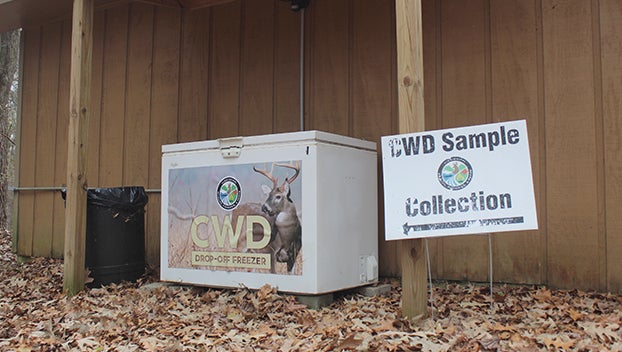‘A canary in the coal mine,’ Chronic Wasting Disease prions found in Claiborne County
Published 11:57 am Thursday, June 22, 2023

- Chronic Wasting Disease samples can be dropped off at Natchez State Park. You can take antlers as long as you leave the skull plate and neck with lymph nodes attached at the drop off cooler. Hunters fill out a sample card at the station with their name, contact information and where the deer was harvested. CWD samples are needed across Mississippi to find new areas of the disease to better contain the disease. (Hunter Cloud | The Natchez Democrat)
|
Getting your Trinity Audio player ready...
|
QUITMAN — Chronic Wasting Disease prions have made their way to Claiborne County. Russ Walsh, Wildlife Chief of Staff, presented an update on Chronic Wasting Disease to the Mississippi Department of Wildlife, Fisheries and Parks Commission Thursday morning in a regularly scheduled meeting and discussed ongoing research at Mississippi State University.
One of the biggest revelations from his presentation was the detection of CWD prions in a scrape located in Claiborne County on the Mississippi side of the river which was reported to Walsh this Tuesday. The finding comes from a Mississippi State University study on surveying for CWD in non-invasive ways.
CWD is a 100 percent always fatal infectious prion disease in deer and other members of the cervidae family. It is often tested in the lymph nodes of a dead deer but the MSU scrape research showed CWD prions could be detected in licking branches and soil.
“They are able to collect soil samples and licking branches from properties. They are finding CWD prions,” Walsh said. “It is A canary in the coal mine detecting CWD early on in certain locations. We are excited about this research and hopefully it will be of value.”
Claiborne County was originally placed in a CWD management zone due to close proximity to positive CWD detections in Tensas Parish, some were just a mile away from Canemount WMA. However, commissioners voted to keep only the portions of the county on the left side of the Mississippi River in the CWD zone and portions to the right side out of the zone in November 2022.
There has not been a positive detection in a dead deer in Claiborne County but there needs to be more deer tested there. MDWFP reports 701 deer have been sampled from the county since 2018. By comparison, Warren County has detected three positives in 1,729 samples since 2018. Claiborne County will not be placed in a CWD management zone with the scrape detection.
The news is a concern due to the commissioners decision to rescind a supplemental feeding ban in Claiborne County opens up the possibility for CWD to spread in the area if there are infected deer.
Supplemental feeding encourages the unnatural concentration of deer and increases the risk for infection especially with Chronic Wasting Disease prions which are persistent in the environment. Food plots are one way hunters can supplementally feed without the use of feeders and improve the quality of their deer herd without increasing disease risk.
Arkansas detected Chronic Wasting Disease too late and as a result has high prevalence rates. Some of the numbers from Arkansas include the Buffalo National River where 32 percent of the deer has Chronic Wasting Disease according to the Arkansas Game and Fish Commission.
Walsh said research in Arkansas shows 17 percent of deer mortality has come directly from CWD and 25 percent were hunter harvested. Research shows the deer population being driven down by CWD, he said. As a result, Arkansas is shifting from managing trophy bucks and working to limit the deer herd density by dropping its antler point restrictions.






